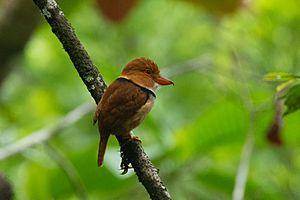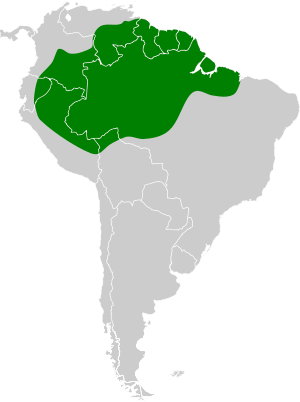Collared puffbird facts for kids
Quick facts for kids Collared puffbird |
|
|---|---|
 |
|
| Conservation status | |
| Scientific classification | |
| Genus: |
Bucco
|
| Species: |
capensis
|
 |
|
The collared puffbird (Bucco capensis) is a type of bird. It belongs to a family called Bucconidae. This family includes puffbirds, nunlets, and nunbirds. You can find this bird in many countries in South America. These include Bolivia, Brazil, Colombia, Ecuador, French Guiana, Guyana, Peru, Suriname, and Venezuela.
Contents
How the Collared Puffbird Got Its Name
In 1766, a famous Swedish scientist named Carl Linnaeus gave this bird its scientific name. He called it Bucco capensis. The name capensis means "from the Cape." Linnaeus mistakenly thought the bird came from the Cape of Good Hope in Africa. However, collared puffbirds actually live in South America.
What Does a Collared Puffbird Look Like?
The collared puffbird is about 19 cm (7.5 in) (7.5 inches) long. It weighs between 46 to 62 g (1.6 to 2.2 oz) (1.6 to 2.2 ounces). Its head and back are a dark reddish-brown color. Its tail is orange-brown with thin black stripes.
It has a white or light yellow chin and throat. This light color goes around its neck in a thin line. Below this, it has a wide black band. This band looks like a collar around its chest and upper back. Its lower chest and belly are light yellow-white. The sides of its body are a dull orange.
The bird's eyes are surrounded by bare orange-yellow skin. Its eye color can be whitish, orange, or red. Its beak is mostly orange with some dark parts. Its feet can be light green, orange, or brown.
Where Do Collared Puffbirds Live?
Collared puffbirds live in most of the Amazon Basin. This huge area covers many countries in South America. They live in places like southeastern Colombia, eastern Ecuador, and northern Bolivia. They are also found in southern Venezuela, the Guianas, and northern Brazil.
They like to live in humid forests. These are often "terra firme" forests, which means they are on higher, drier ground. They can also live in "várzea" forests, which are flooded for part of the year. You can find them from sea level up to 1,700 m (5,600 ft) (5,600 feet) high. However, they usually live below 1,000 m (3,300 ft) (3,300 feet).
How Collared Puffbirds Behave
What Do Collared Puffbirds Eat?
The collared puffbird is a hunter. It waits quietly on a shady branch. Then, it quickly flies out to catch its food. It can grab prey from leaves, tree bark, or the forest floor. They eat lizards, snakes, frogs, and large insects. Sometimes, they join groups of different bird species looking for food. They might also follow swarms of army ants.
How Do Collared Puffbirds Raise Their Young?
Collared puffbirds lay their eggs between May and September. They lay two shiny white eggs. They make their nest in a hole. This hole is usually in a termite nest in a tree or a rotten tree trunk.
What Do Collared Puffbirds Sound Like?
The collared puffbird's song is a quick, meowing sound. It often sounds like "cua-will, cua-will…" or "awww awwAWW-chaw." They usually sing at or just before sunrise. Often, two puffbirds will sing together in a duet.
Are Collared Puffbirds Endangered?
The IUCN (International Union for Conservation of Nature) says the collared puffbird is a species of "Least Concern." This means they are not currently in danger of disappearing. They live across a very large area. However, their numbers are believed to be going down. This is because their forest homes are being disturbed or destroyed. They are common in much of Brazil. But they are rare in the western parts of their range. They live in some protected areas, but they are very sensitive to changes in their habitat.
See also
 In Spanish: Buco musiú para niños
In Spanish: Buco musiú para niños


